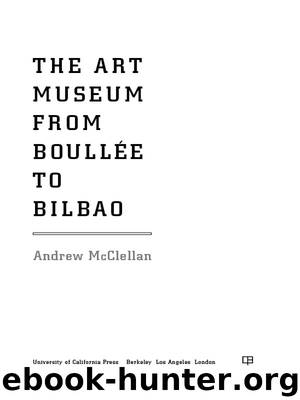Art Museum from Boullee to Bilbao by McClellan Andrew

Author:McClellan, Andrew
Language: eng
Format: epub
Publisher: University of California Press
Art and commerce have long enjoyed an uneasy relationship. Artists have always worked for a living, but beginning with the creation of art academies during the Renaissance they have projected an image of indifference to material concerns. The purpose of early art academies was to elevate the fine arts of painting, sculpture, and architecture above manual labor and the base concerns of the marketplace. In concert with princely patrons who transformed material wealth into symbolic capital through artistic patronage, artists of the early modern period distanced themselves from the artisanal crafts of the guilds by asserting the intellectual, nonmaterial value of their work. Academic art theory worked to ally the “high” arts with poetry, philosophy, and the pleasures of the imagination and to relegate the decorative arts to a lower plane of ornament, craft, and utility. Within the high arts, academies established a hierarchy of genres that deliberately inverted market forces by privileging “history painting” (the depiction of noble human actions) above the more popular and lucrative categories of landscape, still life, and portraiture. From the seventeenth century, the Royal Academy in Paris prohibited its members from engaging in overt commercial activity (advertising, setting up shop, etc.); as recipients of royal patronage and pensions, tax exemptions, exclusive exhibition rights, and royal accommodation, artists were liberated (in theory at least) from the normal circuits of economic exchange. Strictures and privileges may have been weaker in other countries, but in general membership in a fine arts academy implied genteel status and a corresponding distance from money. Sir Joshua Reynolds began his inaugural “Discourse” (1768) to the newly founded Royal Academy in London, for example, by insisting that its members ignore “mercantile” concerns and concentrate instead on the “Polite Arts.”9 What he termed the “inferior ends” of commercial design were consigned to separate organizations established alongside the fine arts academies—in London the Royal Society of the Arts (1753) and in Paris the École Royale Gratuite de Dessin (1767). According to nineteenth-century stereotypes, artists took to living in garrets and wore their lack of material success as a badge of honor.
At the same time, however, governments invested in the fine arts in good part for economic reasons. Producing superior artists glorified the nation, but it also produced objects that could be sold abroad; indeed, one measure of superior art was its standing among foreign patrons. Notwithstanding theoretical distinctions between “high” and “low” art, in France established academy artists produced tapestry and porcelain designs for the royal Gobelin and Sèvres factories, both of which were admired across Europe for the quality of their goods. “Art can be looked at from a commercial point of view,” wrote C. L. von Hagedorn of the Dresden Academy in 1763; “while it redounds to the honour of a country to produce excellent artists, it is no less useful to raise the demand abroad for one's industrial products.”10 Hagedorn had in mind the growing international competition in china and textiles, and he understood that commercial success in the decorative arts depended on high standards of artistry, which it was the function of academies to provide.
Download
This site does not store any files on its server. We only index and link to content provided by other sites. Please contact the content providers to delete copyright contents if any and email us, we'll remove relevant links or contents immediately.
Ways of Seeing by John Berger(1022)
The Perfumes The A-Z Guide by Luca Turin(845)
On Photography by Walter Benjamin(799)
It's Never Too Late to Begin Again by Julia Cameron(776)
Natasha's Dance by Orlando Figes(773)
The Hare with Amber Eyes by Edmund de Waal(771)
0062259628 by Sarah Strohmeyer(723)
The Sound of Paper by Julia Cameron(714)
Minor Feelings by Cathy Park Hong(705)
0544325265 by Brendan Jones(677)
Citizen: An American Lyric by Claudia Rankine(670)
Why Architecture Matters by Paul Goldberger(669)
A Month in Siena by Hisham Matar(662)
Rembrandt Drawings by Rembrandt(645)
And Our Faces, My Heart, Brief As Photos by John Berger(644)
The Selected Poetry of Rainer Maria Rilke by Rainer Maria Rilke(625)
Proust Was a Neuroscientist by Jonah Lehrer(624)
Perfumes the Guide 2018 by Luca Turin(624)
Chaos Imagined by Martin Meisel(614)
